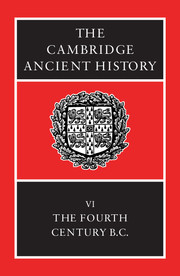Book contents
- Frontmatter
- 1 Sources and their uses
- 2 Sparta as victor
- 3 Persia
- 4 The Corinthian War
- 5 Sicily, 413–368 B.C.
- 6 The King's Peace and the Second Athenian Confederacy
- 7 Thebes in the 360s B.C.
- 8 Regional surveys I: Persian lands and neighbours
- 9 Regional surveys II: the West and North
- 9a Carthage from the battle at Himera to Agathocles' invasion (480–308 B.C.)
- 9b South Italy in the fourth century B.C.
- 9c Celtic Europe
- 9d Illyrians and North-west Greeks
- 9e Thracians and Scythians
- 9f The Bosporan Kingdom
- 9g Mediterranean communications
- 10 Society and economy
- 11 The polis and the alternatives
- 12 Greek culture and science
- 13 Dion and Timoleon
- 14 Macedon and north-west Greece
- 15 Macedonian hegemony created
- 16 Alexander the Great Part 1: The events of the reign
- 17 Alexander the Great Part 2: Greece and the conquered territories
- 18 Epilogue
- Chronological Table
- BIBLIOGRAPHY
- Index
- Map 1: Greece and Western Asia Minor
- Map 9: Egypt
- Map 20: Alexanders campaigns
- References
9a - Carthage from the battle at Himera to Agathocles' invasion (480–308 B.C.)
from 9 - Regional surveys II: the West and North
Published online by Cambridge University Press: 28 March 2008
- Frontmatter
- 1 Sources and their uses
- 2 Sparta as victor
- 3 Persia
- 4 The Corinthian War
- 5 Sicily, 413–368 B.C.
- 6 The King's Peace and the Second Athenian Confederacy
- 7 Thebes in the 360s B.C.
- 8 Regional surveys I: Persian lands and neighbours
- 9 Regional surveys II: the West and North
- 9a Carthage from the battle at Himera to Agathocles' invasion (480–308 B.C.)
- 9b South Italy in the fourth century B.C.
- 9c Celtic Europe
- 9d Illyrians and North-west Greeks
- 9e Thracians and Scythians
- 9f The Bosporan Kingdom
- 9g Mediterranean communications
- 10 Society and economy
- 11 The polis and the alternatives
- 12 Greek culture and science
- 13 Dion and Timoleon
- 14 Macedon and north-west Greece
- 15 Macedonian hegemony created
- 16 Alexander the Great Part 1: The events of the reign
- 17 Alexander the Great Part 2: Greece and the conquered territories
- 18 Epilogue
- Chronological Table
- BIBLIOGRAPHY
- Index
- Map 1: Greece and Western Asia Minor
- Map 9: Egypt
- Map 20: Alexanders campaigns
- References
Summary
SOURCES AND APPROACHES
The two centuries of the history of Carthage with which we deal are crucial: in this period the Tyrian colony becomes a city state important both for the expansion of her African territory to an area of about 30,000 sq.km. (equal to Roman territory in about 300 B.C.), and for her empire of the seas which is practically identical with the western Mediterranean coastal area, except for the much smaller sphere of influence of Marseilles. The acquisition and maintenance of empire were the cause of terrible wars, especially against the Sicilian Greeks. Within the city state, this period corresponds to a change from a monarchical regime to a complex aristocratic one. This evolution has been variously interpreted by modern historians; many think that monarchy was the result of an irregular concentration of power in the hands of a few noble families; others, with whom I agree, consider monarchy an inheritance from the Phoenician colonists. From the religious point of view, the most important cult, which had direct ties with the city state, gave to the goddess Tanit a place at least equal to that held by her partner, Ba'al Hammon, who had previously been named alone in dedications. At the same time, Demeter and Kore were borrowed from the Greeks at the very moment of the most intense struggle between the two cultures.
We discern all these facts through a kind of mist, the result of the great weakness of our sources, composed of very diverse elements of unequal value and often contradictory. No interpretation is entirely sure; we have to appeal to hypotheses in the search for coherence. We first deal briefly with the literary and epigraphic evidence.
- Type
- Chapter
- Information
- The Cambridge Ancient History , pp. 361 - 380Publisher: Cambridge University PressPrint publication year: 1994
References
- 1
- Cited by

